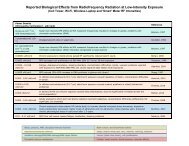Evidence for Effects on Neurology and Behavior - BioInitiative Report
Evidence for Effects on Neurology and Behavior - BioInitiative Report
Evidence for Effects on Neurology and Behavior - BioInitiative Report
You also want an ePaper? Increase the reach of your titles
YUMPU automatically turns print PDFs into web optimized ePapers that Google loves.
dependent increase in the entry of Japanese encephalitis virus into the brain <strong>and</strong> lethality was<br />
reported in mice after 10 min of RFR exposure (power densities 10-50 mW/cm 2 , SARs 24-98<br />
W/kg). The blood-brain barrier is a natural barrier against the penetrati<strong>on</strong> of this virus to the<br />
brain. The authors also speculated that the high-intensity RFR caused an increase in pinocytosis<br />
of the capillary endothelial cells in the central nervous system <strong>and</strong> the viruses were carried inside<br />
by this process.<br />
It is apparent that in the majority of the studies a high intensity of RFR is required to alter<br />
the permeability of the blood-brain barrier. Change in brain or body temperature seems to be a<br />
necessary c<strong>on</strong>diti<strong>on</strong> <str<strong>on</strong>g>for</str<strong>on</strong>g> the effect to occur. In additi<strong>on</strong>, permeability alterati<strong>on</strong> could be due to a<br />
passive change in 'leakiness' or an increase in pinocytosis in the blood-brain barrier.<br />
ELECTROPHYSIOLOGICAL EFFECTS OF<br />
RADIOFREQUENCY RADIATION<br />
Electrophysiology of Neur<strong>on</strong>s<br />
Wachtel et al. [1975] <strong>and</strong> Seaman <strong>and</strong> Wachtel [1978] described a series of experiments<br />
investigating the effect of RFR (1500 <strong>and</strong> 2400 MHz) <strong>on</strong> neur<strong>on</strong>s from the isolated abdominal<br />
gangli<strong>on</strong> of the marine gastropod, Aphysia. Two types of cells generating regular acti<strong>on</strong> potential<br />
spikes or bursts were studied. A majority of cells (87%) showed a decrease in the rate of the<br />
sp<strong>on</strong>taneous activity when they were irradiated with RFR. 'Temperature' c<strong>on</strong>trols were run <strong>and</strong> in<br />
certain neur<strong>on</strong>s c<strong>on</strong>vective warming produced an opposite effect (increased rate of activity) to<br />
that produced by RFR (decreased activity). Chou <strong>and</strong> Guy [1978] exposed temperaturec<strong>on</strong>trolled<br />
samples of isolated frog sciatic nerves, cat saphenous nerve, <strong>and</strong> rabbit vagus nerve to<br />
2450-MHz RFR. They reported no significant change in the characteristics of the compound<br />
acti<strong>on</strong> potentials in these nerve preparati<strong>on</strong>s during exposure to either c<strong>on</strong>tinuous-wave (SARs<br />
0.3-1500 W/kg) or pulsed (peak SARs 0.3-220 W/kg) radiati<strong>on</strong>. No direct field stimulati<strong>on</strong> of<br />
neural activity was observed.<br />
Arber <strong>and</strong> Lin [1985] recorded from Helix aspersa neur<strong>on</strong>s irradiated with c<strong>on</strong>tinuouswave<br />
2450-MHz RFR (60 min at 12.9 W/kg) at different ambient temperatures. The irradiati<strong>on</strong><br />
induced a decrease in sp<strong>on</strong>taneous firing at medium temperatures of 8 <strong>and</strong> 21 o C, but not at 28<br />
o C. However, when the neur<strong>on</strong>s were irradiated with noise-amplitude-modulated 2450-MHz<br />
RFR (20% AM, 2 Hz-20 kHz) at SARs of 6.8 <strong>and</strong> 14.4 W/kg, increased membrane resistance<br />
<strong>and</strong> sp<strong>on</strong>taneous activity were observed.<br />
Evoked Potentials<br />
Several studies investigated the effects of RFR <strong>on</strong> evoked potentials in different brain areas.<br />
The evoked potential is the electrical activity in a specific locati<strong>on</strong> within the central nervous<br />
system resp<strong>on</strong>ding to stimulati<strong>on</strong> of the peripheral nervous system. Johns<strong>on</strong> <strong>and</strong> Guy [1972]<br />
recorded the evoked potential in the thalamus of cats in resp<strong>on</strong>se to stimulati<strong>on</strong> of the<br />
c<strong>on</strong>tralateral <str<strong>on</strong>g>for</str<strong>on</strong>g>epaw. The animals were exposed to c<strong>on</strong>tinuous-wave 918-MHz RFR <str<strong>on</strong>g>for</str<strong>on</strong>g> 15 min<br />
at power densities of 1-40 mW/cm 2 at the head. A power density-dependent decrease in latency<br />
of some of the late comp<strong>on</strong>ents, but not the initial resp<strong>on</strong>se of the thalamic evoked potential was<br />
observed. These data were interpreted that RFR affected the multisynaptic neural pathway,<br />
32



